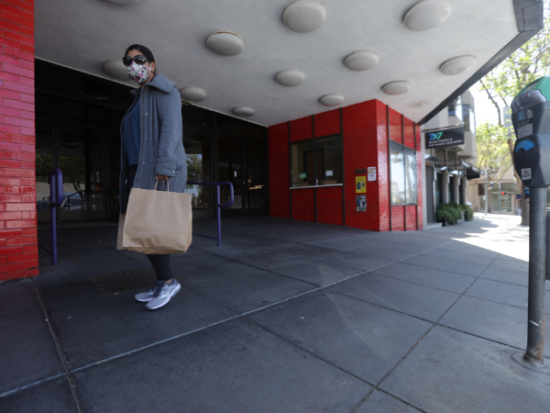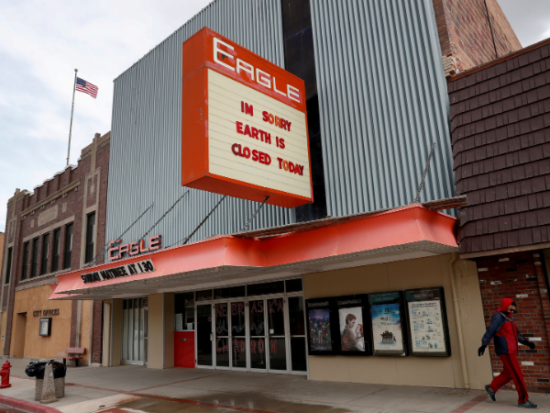Movie theaters face uncertain future from the COVID-19 impact
Maryo Mogannam snuck into the Empire theater in San Francisco with his older cousins to watch “Animal House” when he was 14. He watched most of the James Bond movies at the historic art house and took his wife there on some of their first dates.
Since the silent film era, the cinema, which had been showing movies, served notice in February that it was permanently closing because of the impact of COVID-19. The marquee is now blank, and cardboard and paper cover the box office window.
“It’s kind of like losing a friend,” said Mogannam, now 57, who owns a retail shipping outlet near the theater, which had been renamed the CineArts at the Empire.

A pedestrian walks past a closed CineArts Empire theater in San Francisco, California, U.S. April 14, 2021. The picture was taken on April 14, 2021. REUTERS/Nathan Frandino
As vaccinated Americans emerge from their homes, they also may find their neighborhood theater is not there to greet them.
An eight-cinema chain in New England said it would not reopen. The same fate hit a Houston art house beloved by director Richard Linklater and, in a shock to Hollywood, more than 300 screens run by Los Angeles-based Pacific Theatres. That includes the Cinerama Dome, a landmark that hosted several red-carpet movie premieres.
Following a year of closures, theaters face deferred rent bills plus media companies’ focus on drawing customers to streaming services. Up to one-fourth of the roughly 40,000 screens in the United States could disappear in the next few years, Wedbush Securities analyst Michael Pachter said.
The National Association of Theatre Owners rejects that estimate, spokesman Patrick Corcoran said, noting that similar dire warnings accompanying the advent of television and the switch to digital screens never came to pass.
Hollywood filmmakers want cinemas to thrive.
“It’s the only place where the art dominates,” said “Avatar” director James Cameron. “When you watch something on streaming, the other people in the room with you are welcome to interject, to pause to go to the bathroom, to text.”
At theaters, “we literally make a pact with ourselves to go and spend two to three hours in a focused enjoyment of the art.”
“For 300 people to laugh and cry at the same time, strangers, not just your family in your house, that’s a very powerful thing,” said Chloe Zhao, Oscar-nominated director of best picture nominee “Nomadland.”

A woman walks along an empty sidewalk by the closed Eagle movie theater as the spread of the coronavirus disease (COVID-19) continues in Chadron, Nebraska, U.S., April 15, 2020. REUTERS/Shannon Stapleton/File PhotoDOWNLOAD PICTUREDOWNLOAD WATERMARKED COMP
At the Academy Awards on Sunday, the movie industry will “make a case for why cinema matters,” producer Stacey Sher said. While acknowledging the hardship of the pandemic, “we also have to fight for cinema and our love of it and the way it has gotten us through things,” she said.
About 58% of theaters have reopened in the United States and Canada, most-restricted to 50% capacity or less. The biggest operators – AMC, Cinemark, and Cineworld – make up roughly half the overall market.
Industry leaders project optimism, forecasting a big rebound after restrictions ease and studios unleash new blockbusters.
Coming attractions include a new Bond adventure, the ninth “Fast & Furious” film, a “Top Gun” sequel, and several Marvel superhero movies.
“Avatar 2,” Cameron’s follow-up to the highest-grossing film of all time, is set to debut in December 2022. Some box office analysts predict 2022 ticket sales will hit a record.
Supporters point to the late March release “Godzilla vs. Kong,” which brought in roughly $48.5 million at U.S. and Canadian box offices over its first five days, even though audiences could stream it on HBO Max.
“That was a big win for the entire industry,” said Rich Daughtridge, president and chief executive of Warehouse Cinemas in Frederick, Maryland.
Related Articles
Best Romance Movies on Netflix
What Are Economic Impact Payments?
But near- and long-term challenges loom, particularly for smaller cinemas.
Theaters are negotiating with landlords over back rent. A federal aid program was delayed due to technical problems.
Plus, media companies are bringing movies to homes sooner. Executives say streaming is their priority, pouring billions into programming made to watch in living rooms as they compete with Netflix Inc.
Most at risk are theaters with one or two screens, Wedbush Securities’ Pachter said. He said his best guess is between 5,000 and 10,000 screens could go permanently dark in coming years.
“I think we’ll see a gradual decline in the number of screens,” Pachter said, “just like we’ve seen a gradual decline in the number of mom-and-pop grocery stores and bookstores.”
(Reporting by Lisa Richwine; Additional reporting by Rollo Ross in Los Angeles, Alicia Powell in New York and Nathan Frandino in San Francisco; Editing by Jonathan Oatis)

